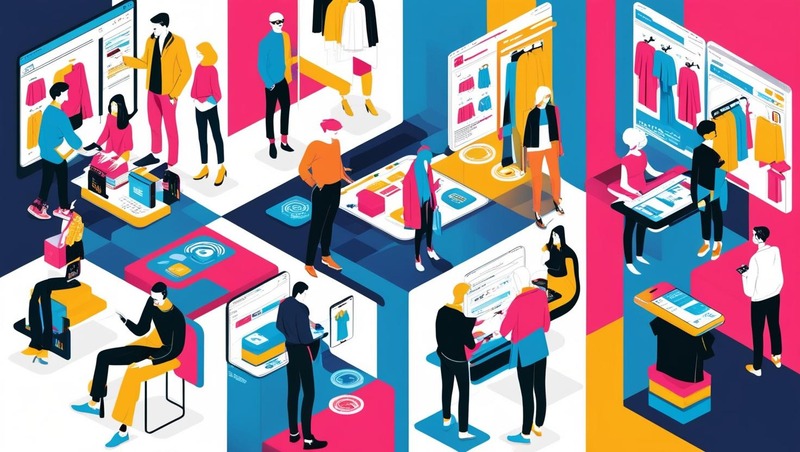By Nina Weiß
As consumers, we like to believe our choices are personal and unique, but they are influenced by systems designed to predict our preferences. Algorithms are everywhere, quietly shaping so many parts of our lives. They determine what shows up on our screens and shape what we see, think and consume. One significant area where this becomes visible is in fashion. From Instagram feeds to shopping apps like ASOS or Zalando, algorithms are constantly influencing what we wear, how we buy, and even what style we like.
The Role of Recommendation Algorithms
One of the most obvious ways algorithms impact fashion consumption is through recommendation systems. These are the mechanisms behind the “you might also like” suggestions on shopping websites and social media platforms, these algorithms use machine learning models trained on user behaviour. Clicks, likes, time spent on a product, and past purchases lead to personalize recommendations (Rahrovani et al. 2025; Duffy & Meisner, 2023). While this can be useful, it also narrows our view to a limited set of styles and brands. In other words, we often end up in a “filter bubble”, where our taste is limited by what the algorithm believes we want (Pariser, 2011).

Influence of Social Media Platforms
Platforms like Instagram, TikTok, and Pinterest have become digital runways. They not only show fashion trends but also co-create them through user engagement. Here, algorithms play a huge role in determining what content becomes viral. The more engagement a fashion post receives, the more it is pushed into the feeds of similar users, creating a kind of feedback loop (Pariser, 2011).
TikTok’s algorithm promotes novelty and virality, which promotes fast trend cycles and fast fashion consumption. This system motivates influencers to constantly promote new styles and brands, which contributes to a culture of overconsumption. As trends change more rapidly, users feel pressured to keep up, leading to more frequent purchases, often from fast fashion brands. The environmental consequences of this are huge. Fast fashion leads to significant carbon emissions and textile waste (Alanya, 2024).
Emotional Triggers and Consumer Behaviour
Erevelles et al. (2016) point out that data-driven personalization in online marketing isn’t just about making shopping more comfortable or enjoyable for customers. It’s about getting people to buy more. In fashion e-commerce, you can see this in things like “Only 3 left in stock!” messages or countdown timers during checkout. These features are based on real-time data and are meant to make us feel like we must act quickly, so we don’t miss out (Kaptein & Eckles, 2012). According to Cialdini (2009), these kinds of scarcity and urgency tactics are very effective at influencing our decisions. Over time, this can lead to people associate feelings of happiness or self-expression with buying new things, especially in fast fashion where trends change so quickly, and social media adds even more pressure to keep up.

Can We Resist Algorithmic Influence?
Awareness is the first step. By understanding how algorithms work, we can become more critical of our own behaviour. Ethical fashion influencers and digital minimalism movements are already encouraging people to take control of their consumption. Tools that block tracking, or platforms that promote slow fashion, are ways to push back against the algorithmic influence.
In conclusion, algorithms have reshaped how we consume fashion, often in ways we don’t even notice. While they offer comfort and personalization, they also risk limiting our choices, speeding up trend cycles, and fuelling overconsumption. As consumers, it’s up to us to interact with these systems thoughtfully, and dress with both style and conscience.
Do you think algorithm-driven recommendations help you discover your personal style, or do they limit your creativity to new ideas?
References
Alanya, L. (2024). TikTok’s Role in Accelerating Fashion Cycles and Promoting Overconsumption. Kylteri, 1/24. Abgerufen am 19. Mai 2025, von https://www.kylteri.fi/artikkelit/tiktoks-role-in-accelerating-fashion-cycles-and-promoting-overconsumption
Cialdini, R. B. (2009). Influence: Science and Practice (5th ed.). Pearson.
Duffy, B. E., & Meisner, C. (2023). Platform governance at the margins: Social media creators’ experiences with algorithmic (in)visibility. Media, Culture & Society, 45(2), 285-304.
Erevelles, S., Fukawa, N., & Swayne, L. (2016). Big Data consumer analytics and the transformation of marketing. Journal of Business Research, 69(2), 897-904. https://doi.org/10.1016/j.jbusres.2015.07.001
Kaptein, M., & Eckles, D. (2012). Heterogeneity in the Effects of Online Persuasion. Journal of Interactive Marketing, 26(3), 176-188. https://doi.org/10.1016/j.intmar.2012.02.002
Pariser, E. (2011). The Filter Bubble: What the Internet Is Hiding from You. Penguin Press.
Rahrovani, Y., Jarrahi, M., Glaser, V., & Karami, A. (2025). AI as a Dual Agent in a Trio Dance: Unpacking the Dynamic Interplay of Designers, Users, and AI Systems.
Leave a Reply